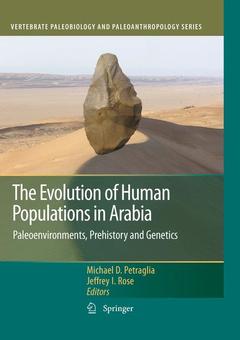The Evolution of Human Populations in Arabia, 2010 Paleoenvironments, Prehistory and Genetics Vertebrate Paleobiology and Paleoanthropology Series
Coordonnateurs : Petraglia Michael D., Rose Jeffrey I.

Michael D. Petraglia was born in New York in 1960. He is currently a Senior Lecturer in the Leverhulme Centre for Human Evolutionary Studies, University of Cambridge. Over the past 25 years, he has conducted archaeological research in India, Arabia, Europe and North America. He is co-editor of the book, The Evolution and History of Human Populations in South Asia (Springer).
Jeffrey Ian Rose was born in Princeton, New Jersey in 1975. Over the past 20 years, he has conducted fieldwork in prehistoric archaeology throughout North America, Europe, and Arabia. He is currently a Senior Lecturer in the Department of Anthropology and Geography at Oxford Brookes University and runs an ongoing archaeological research project in the Sultanate of Oman.
First book on prehistory of Arabia
Includes multidisciplinary subjects such as paleoenvironments, archaeology, genetics and linguistics
Provides a more comprehensive picture about human adaptations and population changes
Presents new theories and methodologies providing new interpretations about cultural history and evolution of populations in Arabia
Includes supplementary material: sn.pub/extras
Date de parution : 03-2012
Ouvrage de 312 p.
21x27.9 cm
Disponible chez l'éditeur (délai d'approvisionnement : 15 jours).
Prix indicatif 137,14 €
Ajouter au panierDate de parution : 12-2009
Ouvrage de 312 p.
21x27.9 cm
Thèmes de The Evolution of Human Populations in Arabia :
Mots-clés :
DNA; Middle Paleolithic; Pleistocene; evolution; genetics; paleolithic; the origin
